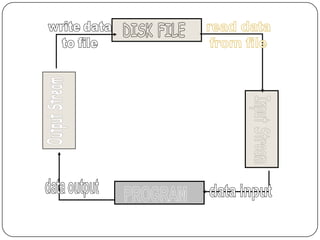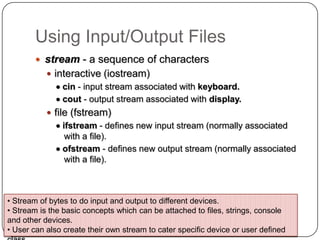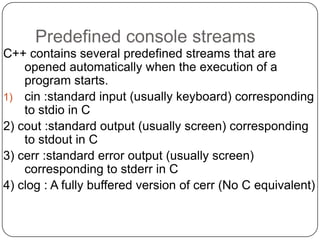basics of file handling
- 1. Basics of File Handling Name-Pinkpreet Kaur Section-N1 Roll no.-115329
- 2. Contents of presentation Using input/output files General files I/O steps Using input/output files Streams Predifined console streams File modes File pointers Binary file operations
- 3. Using Input/Output Files Files in C++ are interpreted as a sequence of bytes stored on some storage media. The data of a file is stored in either readable form or in binary code called as text file or binary file. The flow of data from any source to a sink is called as a stream Computer programs are associated to work with files as it helps in storing data & information permanently. File - itself a bunch of bytes stored on some storage devices. In C++ this is achieved through a component header file called fstream.h The I/O library manages two aspects- as interface and for transfer of data. The library predefine a set of operations for all file related handling through certain classes.
- 4. Using Input/Output Files A computer file is stored on a secondary storage device (e.g., disk); is permanent; can be used to provide input data to a program or receive output data from a program, or both; must be opened before it is used.
- 5. General File I/O Steps Declare a file name variable Associate the file name variable with the disk file name Open the file Use the file Close the file
- 6. Using Input/Output Files Streams act as an interface between files and programs. In C++ . A stream is used to refer to the flow of data from a particular device to the program’s variablesThe device here refers to files, keyboard, console, memory arrays. In C++ these streams are treated as objects to support consistent access interface. They represent as a sequence of bytes and deals with the flow of data. Every stream is associated with a class having member functions and operations for a particular kind of data flow. File -> Program ( Input stream) - reads Program -> File (Output stream) – write All designed into fstream.h and hence needs to be included in all file handling programs. Diagrammatically as shown in next slide
- 8. Using Input/Output Files stream - a sequence of characters interactive (iostream) cin - input stream associated with keyboard. cout - output stream associated with display. file (fstream) ifstream - defines new input stream (normally associated with a file). ofstream - defines new output stream (normally associated with a file). • Stream of bytes to do input and output to different devices. • Stream is the basic concepts which can be attached to files, strings, console and other devices. • User can also create their own stream to cater specific device or user defined
- 9. Streams A stream is a series of bytes, which act either as a source from which data can be extracted or as a destination to which the output can be sent. Streams resemble the producer and consumer model The producer produces the items to be consumed by the consumer. The producer and the consumers are connected by the C++ operators >> or <<. For instance , the keyboard exhibits the nature of only a producer,printer or monitor screen exhibit the nature of only a consumer. Whereas , a file stored on the disk , can behave as a producer or consumer, depending upon the operation initiated on it.
- 10. Predefined console streams C++ contains several predefined streams that are opened automatically when the execution of a program starts. 1) cin :standard input (usually keyboard) corresponding to stdio in C 2) cout :standard output (usually screen) corresponding to stdout in C 3) cerr :standard error output (usually screen) corresponding to stderr in C 4) clog : A fully buffered version of cerr (No C equivalent)
- 11. Why to use Files Convenient way to deal large quantities of data. Store data permanently (until file is deleted). Avoid typing data into program multiple times. Share data between programs. We need to know: how to "connect" file to program how to tell the program to read data how to tell the program to write data error checking and handling EOF
- 12. File Modes Name Description ios::in Open file to read ios::out Open file to write ios::app All the date you write, is put at the end of the file. It calls ios::out ios::ate All the date you write, is put at the end of the file. It does not call ios::out ios::trunc Deletes all previous content in the file. (empties the file) ios::nocreate If the file does not exist, opening it with the open() function gets impossible. ios::noreplace If the file exists, trying to open it with the open() function, returns an error. ios::binary Opens the file in binary mode.
- 13. File Modes Opening a file in ios::out mode also opens it in the ios::trunc mode by default. That is, if the file already exists, it is truncated Both ios::app and ios::ate set the pointers to the end of file, but they differ in terms of the types of operations permitted on a file. The ios::app allows to add data from end of file, whereas ios::ate mode allows to add or modify the existing data anywhere in the file. In both the cases the file is created if it is non existent. The mode ios::app can be used only with output files The stream classes ifstream and ofstream open files in read and write modes by default.
- 14. File pointers Each file has two associated pointers known as the file pointers. One of them is called the input pointer or get pointer. The get pointer specifies a location from which the current reading operation is initiated Other is called the output pointer or put pointer. The put pointer specifies a location from where the current writing operation is initiated We can use these pointers to move through the files while reading or writing. The input pointer is used for reading the contents of a given file location and the output pointer is used for writing to a given file location. Functions for manipulation of file pointers seekg() Moves get pointer (input) to a specified location. seekp() Moves put pointer (output) to a specified location. tellg() Gives the current position of the get pointer. tellp() Gives the current position of the put pointer.
- 15. File Open Mode #include <fstream> int main(void) { ofstream outFile("file1.txt", ios::out); outFile << "That's new!n"; outFile.close(); Return 0; } If you want to set more than one open mode, just use the OR operator- |. This way: ios::ate | ios::binary
- 16. Dealing with Binary files Functions for binary file handling get(): read a byte and point to the next byte to read put(): write a byte and point to the next location for write read(): block reading write(): block writing flush():Save data from the buffer to the output file.
- 17. Reading /Writing from/to Textual Files #include <fstream.h> To write: main() put() – writing single character { << operator – writing an object // Writing to file ofstream OutFile("my_file.txt"); To read: OutFile<<"Hello "<<5<<endl; get() – reading a single character of a OutFile.close(); buffer getline() – reading a single line int number; >> operator – reading a object char dummy[15]; // Reading from file ifstream InFile("my_file.txt"); InFile>>dummy>>number; InFile.seekg(0); InFile.getline(dummy,sizeof(dummy)); InFile.close(); }
- 18. Binary file operations In connection with a binary file, the file mode must contain the ios::binary mode along with other mode(s) To read & write a or on to a binary file, as the case may be blocks of data are accessed through the use of C++ read() and write() respectively.
- 19. Handling binary data #include <fstream> using namespace std; int main(){ ifstream in(“binfile.dat”); ofstream out(“out.dat”); if(!in || !out) { // return} unsigned int buf[1024]; while(!in){ in.read(buf, sizeof(unsigned int)*1024); out.write(buf, sizeof(unsigned int)*1024); }
- 20. THANKS
















![Reading /Writing from/to Textual Files
#include <fstream.h>
To write: main()
put() – writing single character {
<< operator – writing an object // Writing to file
ofstream OutFile("my_file.txt");
To read:
OutFile<<"Hello "<<5<<endl;
get() – reading a single character of a OutFile.close();
buffer
getline() – reading a single line int number;
>> operator – reading a object char dummy[15];
// Reading from file
ifstream InFile("my_file.txt");
InFile>>dummy>>number;
InFile.seekg(0);
InFile.getline(dummy,sizeof(dummy));
InFile.close();
}](https://image.slidesharecdn.com/filehandlinginc-120315234141-phpapp02/85/basics-of-file-handling-17-320.jpg)

![Handling binary data
#include <fstream>
using namespace std;
int main(){
ifstream in(“binfile.dat”);
ofstream out(“out.dat”);
if(!in || !out) { // return}
unsigned int buf[1024];
while(!in){
in.read(buf, sizeof(unsigned
int)*1024);
out.write(buf, sizeof(unsigned
int)*1024);
}](https://image.slidesharecdn.com/filehandlinginc-120315234141-phpapp02/85/basics-of-file-handling-19-320.jpg)
